VRRS BeefUp and field day
Third time lucky!
The Northern Territory Government’s Department of Industry, Tourism and Trade (the department) hosted a field day and Meat and Livestock Australia (MLA) BeefUp event at the department’s Victoria River Research Station (VRRS). This time, it was able to proceed without the interruption of COVID lockdowns and restrictions, after previously being postponed twice.
More than 70 people travelled through the picturesque Victoria River District to VRRS to attend the two-day event. Arriving on Monday evening, guests were greeted with dinner and drinks looking out to a spectacular sunset over the ranges.
Day one
Day one opened with an official welcome to VRRS by the department’s Senior Executive Director Agriculture, Phil Hausler. Livestock Extension Officer, Stacey Holzapfel followed, providing an overview of the department's current projects. MLA’s David Beatty delivered an industry outlook and provided an update of the latest foot-and-mouth disease threat information.
Biosecurity concerns addressed
The biosecurity procedures attendees completed upon arrival prompted conversation during the ’biosecurity threat assessment’ session hosted by Phil Hausler. During this session attendees also asked questions and shared concerns about the animal disease threats posed by foot-and-mouth disease and lumpy skin disease. We were very fortunate to have the Department of Agriculture, Fisheries and Forestry Deputy Secretary, David Hazlehurst, in attendance to comment on biosecurity threats on behalf of the Australian Government.

Pasture management after a poor season
Following a particularly poor wet season at VRRS, it was fitting to move the focus to pasture management after morning tea.
Cibo Labs Managing Director, Phil Tickle, spoke about how satellite imagery can be used to map and monitor pasture biomass and play an important part in managing paddock variability between seasons.
This was followed by a panel session, facilitated by Heytesbury’s General Manager, Rusty Richter. The department’s Senior Rangeland Scientist, Robyn Cowley, discussed planning for seasonal variability and understanding the expected range of pasture growth. The North Australia Climate Program’s Emily Hinds followed this up with helpful forecasting tools available to producers. AACo Rangelands Manager, Dan Chapman, shared insights on how they assess and manage land condition and the feedbase on their properties. Producer and Upriver NT consultant, Trudi Oxley, explained how forage budgeting can assist with many management decisions.
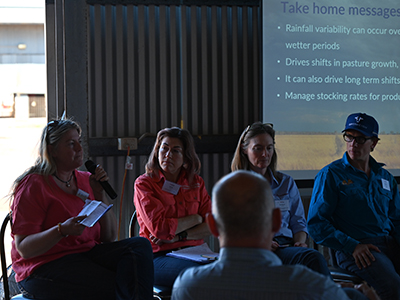
Project updates
After lunch, everyone headed out to the paddock to see first-hand some of the projects underway at VRRS.
First up, was the EasyP project led by the department’s Principal Livestock Research Officer, Tim Schatz. He explained that performance from the two phosphorus supplementation methods, Easy P and traditional, has been similar so far. People were able to view the treatments side by side and they looked very similar.

The next stop was amongst the treatment plots of the Shruburn project, where Dr Robyn Cowley discussed findings from 30 years of burning to manage pasture and woody cover. Dr Cowley outlined the differences between the management required of red and black soil sites, and the planning needed when burning paddocks on commercial cattle properties.
In contrast, Northern Territory Parks and Wildlife team member, Tom Manual, explained how fire is used to reduce the frequency of hot late dry season fires, reduce greenhouse gas emissions and earn carbon credits in the neighbouring Judbarra/Gregory National Park.
University of Queensland Arid Soil Ecologist, Wendy Williams, was on hand to introduce current research on the nitrogen fixing biocrusts that can be seen growing on the soil surface. Ms Williams’ work is investigating their benefits to pastures and what effect fire has on them.
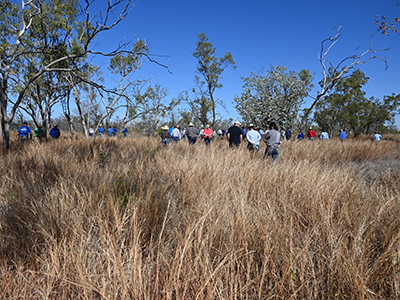
The convoy of 4WDs then moved on to the last stop, where the department’s Livestock Research Officer, Gretel Bailey-Preston, spoke about the Selected Brahman and Composite herds. In these herds, heavy selection pressure is placed on fertility by only keeping cows that are pregnant and lactating every year. Cattle from these herds are involved in the collaborative Repronomics 2 project.
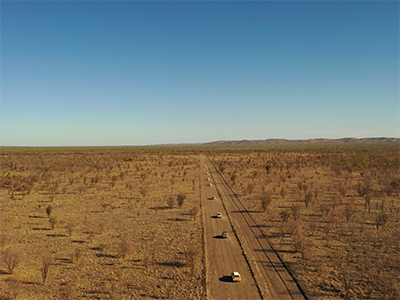
Day one ended with another spectacular sunset on the hill, a five-star dinner cooked by the event caterers, Ryan and Tracey Fenton, and drinks sponsored by Australian Cattle Enterprises.
Day 2
Carbon farming
The second morning opened with the hot topic of carbon farming.
MLA Carbon Neutral 2030 program manager, Margaret Jewell, provided an insightful presentation on strategies to reduce greenhouse gas emissions. In particular, Ms Jewell focussed on relevant and practical options fit for the average Northern Territory beef enterprise. Attendees learnt the first steps to setting up a carbon account and where to find more information.
The following session was a producer engagement workshop, led by MLA’s Gus Rose and Katherine Pastoral Industry Advisory Committee Chair, Jay Mohr-Bell. This gave everyone a chance to discuss what they thought were top research priorities and put these down on paper. Some of the most popular responses were calf loss, feed base improvement and sustainable grazing, nutrition and the rate of adoption of phosphorus supplementation, and staff retention.
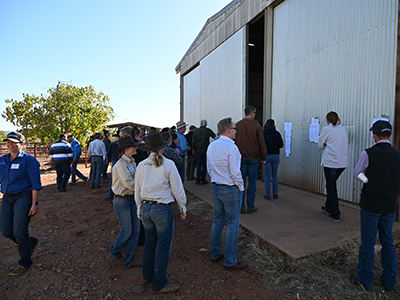
Calf loss
Straight after acknowledging calf loss as an area that many people would like to see more research into, University of Queensland Senior Research Fellow and former department staff member, Dr Kieren McCosker, and the department’s Livestock Research Officers, Tim Schatz, Dr Christie Pearson and Melissa Wooderson, presented findings from their own calf loss and welfare studies.
Dr McCosker spoke about his research into providing artificial shade for cattle on the Barkly Tablelands. To date, the provision of shade has appeared to have had minimal effect on calf loss.
Mr Schatz followed by discussing the use of remote technologies to identify when a cow is calving. The technology has been assisting researchers locate calving cows in large paddocks so targeted research can be conducted to determine the causes of calf loss.
Dr Pearson’s studies into calf loss also used remote technologies, with the addition of fitting GPS collars to calves to assess their behaviour in the first few weeks after birth.
Lastly, Ms Wooderson spoke about her research into administering pain relief products when dehorning and castrating weaners. She explained that so far, the results have shown minimal benefits to behaviour and production from providing pain relief.
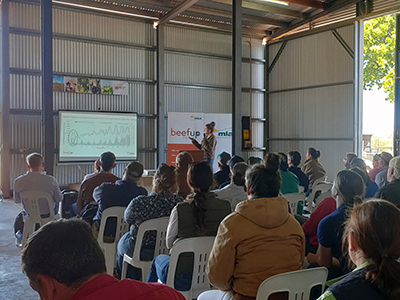
Live export
The last session of the day was another great panel session, facilitated by ABC Country Hour host, Matt Brann.
Mr Brann hosted the whole event with the help of fellow reporter, Max Rowley, who even managed to squeeze in a couple of interviews that aired on the ABC NT Country Hour. This final panel session focused on live export, with Mr Hazlehurst, David Beatty, Australian Cattle Enterprises’s Patrick Underwood and AUSTREX Manager of Animal Welfare Assurance, Kari Moffat. Panellists shared their perspectives on the current opportunities and challenges in the live export industry.
Not surprisingly, current biosecurity threats were again a feature of this session, however attendees were reassured by the panellists messages and how well managed all aspects of the Australian live export industry are.

By the afternoon of the second day, everyone had headed home with a load of information to take on board.
With thanks
We’d like to thank everyone that was in attendance for travelling some fairly long distances to attend the event.
Thank you also for the amazing feedback we have received on the presentations, projects and cattle at VRRS.
A shout out to BeefUp coordinators Rosie Peace and Nat Bell; MLA Manager of Northern Beef Adoption, Harriet Bawden; and the department staff who all played a huge role in helping organise and run the combined MLA and Department of Industry, Tourism and Trade event.
For more information on any of the presentations or department projects, contact the presenters or project leaders directly. You can also email the department’s Livestock Extension Officer, Stacey Holzapfel, at Stacey.holzapfel@nt.gov.au
